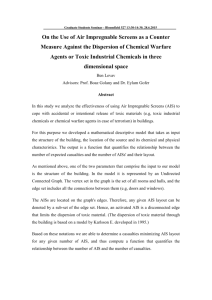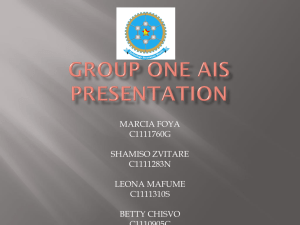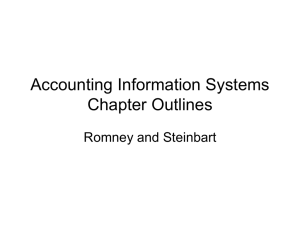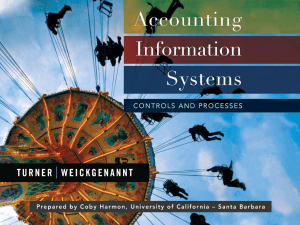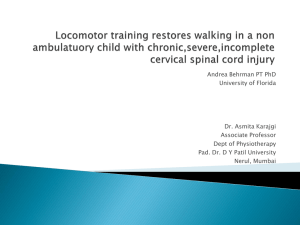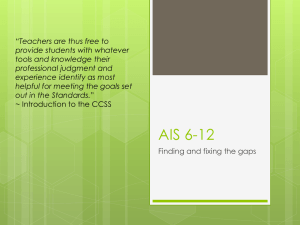AIS PowerPoint Presentations
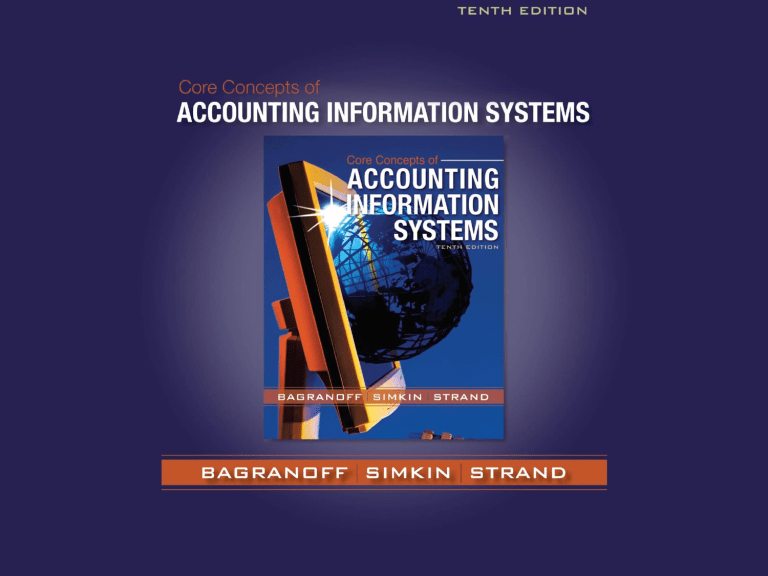
Chapter
1-1
Chapter 1
Accounting Information Systems and the Accountant
Introduction
Accounting Information Systems (AIS)
New Features in AIS
Accounting and IT
Chapter
1-2
Chapter 1
Accounting Information Systems and the Accountant
Careers in Accounting Information
Systems
AIS at work - Planning for disaster
Summary
Chapter
1-3
Introduction
Application of information technology (IT) to accounting systems
financial accounting, managerial accounting,
auditing,
taxation, and
Study of accounting information systems for understanding
business processes,
computerized software, and information flows that are all part of AIS.
Chapter
1-4
Introduction
Increase in career opportunities with
minimum level of computer proficiency accounting skills combined with computer knowledge
advanced computer skills in accounting jobs
awareness of new developments in the field.
Chapter
1-5
Accounting Information Systems
Question
Which of the following is not a good reason to study accounting information systems?
a. You will be on the cutting edge of business practice.
b. You get to draw pictures.
c. You can get a great job.
d. You like to spend hours and hours chatting on the
Internet.
Chapter
1-6
The Information Age
Information in this age is
produced very quickly,
analyzed efficiently, and
distributed effectively.
Knowledge workers
constitute the labor force in this age.
The Internet
is a major contributor in the information age.
Chapter
1-7
Information Systems(IS)
A S ystem
consists of interacting parts or components,
is set up to achieve one or more goals.
An I nformation System
is a set of interrelated subsystems,
works to collect, process, store, transform, and
distribute information, helps to plan, make decisions, and control processes.
A Firm/Company
depends on information systems to stay competitive.
Chapter
1-8
The Accounting Field
The Accounting Field includes
financial accounting,
managerial accounting, and
taxation
The Accounting System of old is the
Management Information System (MIS) which provided
financial information and
nonfinancial information
Chapter
1-9
AIS: At the Intersection of
Accounting and IS
Accounting financial accounting, managerial accounting, and taxation
Accounting
Information
Systems
Information Systems collect, process, store, transform, and distribute
Chapter
1-10
Accounting Information Systems
An Accounting Information System (AIS)
Collection of data and processing procedures
Creates needed information for users.
The AIS today should be
an enterprise-wide information system,
focused on business processes.
Chapter
1-11
An Accounting Information
System
Inputs: Collection of Data/Information from
Internal/External sources
Data
Repository/
Files,
Databases, etc.
Processes: Sorting, Organizing,
Calculating
Outputs: Distribution of Information for Internal/
External Decision Makers
Chapter
1-12
An Accounting Information
System
Question
Which of the following is NOT true about accounting information systems (AISs)?
a. All AISs are computerized.
b. AISs may report both financial and nonfinancial information.
c. AISs, in addition to collecting and distributing large amounts of data and information, also organize and store data for future uses.
d. A student who has an interest in both accounting and IT will find many job opportunities that combine these knowledge and skills areas.
Chapter
1-13
Data versus Information
Data raw facts about events that have no organization or meaning
Information data that have been processed and made meaningful to users
Chapter
1-14
MIS versus AIS
A Management Information System provides to internal users (management)
financial information and
nonfinancial information.
Chapter
1-15
MIS versus AIS
The Accounting Information System provides to both external and internal users
financial information
Now, the two systems overlap to provide the same information focusing on business processes.
Chapter
1-16
MIS versus AIS
MIS
MIS systems overlap
AIS
Chapter
1-17
AIS
Financial
Nonfinancial
Financial
To internal users to provide the same information to focus on business processes
To internal
& external users
MIS versus AIS
Question
With respect to computerized AISs, computers: a. Turn data into information in all cases.
b. Make audit trails easier to follow.
c. Cannot catch mistakes as well as humans.
d. Do not generally process information more quickly than humans.
Chapter
1-18
Accounting in the
Information Age
Financial Accounting
Managerial Accounting
Auditing
Taxation
Chapter
1-19
New Features in AIS
AIS has several new applications today:
In countering terrorism AIS is using banking systems to trace the flow of funds and materials across international borders.
In preventing accounting scandals AIS is helping firms to to comply with the Sarbanes-Oxley Act of
2002.
AIS has benefited from the use of
WI-FI Technology
Chapter
1-20
Recent Accounting Scandals
The following is a list of recent accounting scandals that were reported:
Enron 2001
Imclone 2001
Arthur Andersen 2001
Merrill Lynch 2002
Tyco 2002
Adelphia 2002
Global Crossing 2002
Parmalat 2003
NYSE 2003
WorldCom 2003
HealthSouth 2003
Chapter
1-21
The Sarbanes-Oxley Act of 2002
Sarbanes-Oxley Act of 2002 is a strong deterrent to unethical behavior; forbids corporations from making personal loans to executives; requires CEOs of companies to personally vouch for the accuracy and completeness of its financial statements; requires public companies to hire independent, new auditors to review internal controls; requires management to implement and assess internal controls; has created a lot of work for accountants and information
1-22
The Sarbanes-Oxley Act of 2002
Question
Which of the following is not true of The Sarbanes-Oxley Act of 2002?
a.
Was enacted as a response to the corporate frauds that left investors uncertain about U.S. financial markets.
b.
Has lead to a decrease in the amount of work done by auditors and accountants.
c.
Forbids corporations from making personal loans to executives.
d.
Requires the Chief Executive Officer of a public company to take responsibility for the reliability of its financial statements.
Chapter
1-23
Chapter
1-24
Accounting and IT
Financial Accounting
The objective of financial accounting is
to provide relevant information to individuals and groups outside an organization’s boundaries.
The users include
investors,
tax agencies, and
creditors.
The objectives are achieved through
Chapter
1-25
preparation of financial statements.
Financial Accounting
Inputs
transactions are measured in monetary units.
A good audit trail
information users can follow the flow of data through the system
managers can follow source document data from input through processing to the output (& vice versa)
The accounting cycle
parallels the audit trail begins with a transaction
ends with producing financial statements and closing temporary accounts.
Chapter
1-26
Chapter
1-27
A Financial Accounting
Audit Trail
Financial AIS - Criticisms
& Solutions
Criticism
Did not provide nonfinancial data
Financial statements are periodic. Too much aggregation of information
Data is not interactive - data used in one application are not easily transferable to another
Solutions
Recommended disclosure of nonfinancial performance measures.
Reporting of disaggregated information tracks sales and many of its expenses continually
Extensible business reporting language (XBRL) is emerging as the language of choice for interactive data
Chapter
1-28
Managerial Accounting
Objective:
to provide relevant information to internal
parties (or users).
Components:
Cost Accounting
Budgeting
Chapter
1-29
Managerial Accounting -
Features
Managerial Accounting
focuses on accounting information
for internal parties, such as management,
not for for external investors and creditors.
is mostly forward-looking.
is not regulated by generally accepted accounting principles, nor is mandatory to prepare.
Chapter
1-30
Managerial Accounting -
Features
includes both nonmonetary and financial data.
is influenced by many business and nonbusiness disciplines, such as economics, behavioral science, quantitative methods is flexible and frequently involves nonroutine reporting.
Chapter
1-31
Cost Accounting
Cost accounting assists managers in the organization’s measuring and controlling the costs associated with: acquisitions processing distribution selling activities .
Chapter
1-32
Cost Accounting
Activity-based costing systems assign overhead to products based on cost drivers.
Corporate performance measurement
Identifies unfavorable performance
Traces to the department or individual responsible for the inefficiencies.
Allows management to take immediate corrective action .
Chapter
1-33
Cost Accounting
The Balance Scorecard approach u ses performance measurements in:
Chapter
1-34
financial performance customer knowledge internal business processes learning and growth
Budgeting
Definition
a financial projection for the future and valuable managerial planning aid
Useful
for managerial control and to compare actual results to budgeted results.
Influence
on all the subsystems within an organization .
Chapter
1-35
Auditing
Traditional role
to evaluate the accuracy and completeness of a corporation’s financial statements
Present role
in the assurance business; the business of providing third-party testimony that a client complies with a given statute, law, or similar requirement
Chapter
1-36
Auditing
CPA Trust Services
include online privacy evaluations, security audits, testing the integrity of information processing systems
assessing availability of IT services, and systems confidentiality testing.
Chapter
1-37
Assurance Services identified by the
AICPA Special Committee
Risk Assessment
Business Performance Measurement
Information Systems Reliability
Electronic Commerce
Health Care Performance
Measurement
Eldercare Plus
Chapter
1-38
Taxation
Taxation software are examples of AISs enable users to create and store copies of trial tax returns help examine consequences of alternate tax strategies print specific portions of a return transmit completed copies of a tax return to the appropriate government agency
Chapter
1-39
Taxation
Professionals can use taxation software to access electronic tax libraries on CDs or online to research challenging tax questions to get more up-to-date tax information access databases of federal and state tax laws, tax court rulings, court decisions, and technical advice.
Chapter
1-40
Careers in Accounting
Information Systems
Systems consultants provide help with information systems in
Designing information systems,
selecting hardware and software, or
reengineering business processes.
Value-added resellers (VARs ) sell a certain software program and
1-41
Careers in Accounting
Information Systems
Information systems auditors analyze risks associated with computerized information systems can show organizations ways that their computer systems could be penetrated can be licensed as Certified Information Systems
Auditors (CISA) can obtain the certification from the Information
Systems Audit and Control Association (ISACA)
Chapter
1-42
Planning for Disaster
Chapter
1-43
Planning assures that operations continue after disaster
IT particularly vulnerable to man-made attacks, such as viruses and worms
Under auditing standard No. 60, absence of disaster plan needs to be reported.
Plan needs to be tested regularly.
Copyright
Copyright 2007 John Wiley & Sons, Inc. All rights reserved.
Reproduction or translation of this work beyond that permitted in
Section 117 of the 1976 United States Copyright Act without the express written permission of the copyright owner is unlawful.
Request for further information should be addressed to the
Permissions Department, John Wiley & Sons, Inc. The purchaser may make backup copies for his/her own use only and not for distribution or resale. The Publisher assumes no responsibility for errors, omissions, or damages, caused by the use of these programs or from the use of the information contained herein.
Chapter
1-44
Chapter 1
Chapter
1-45
